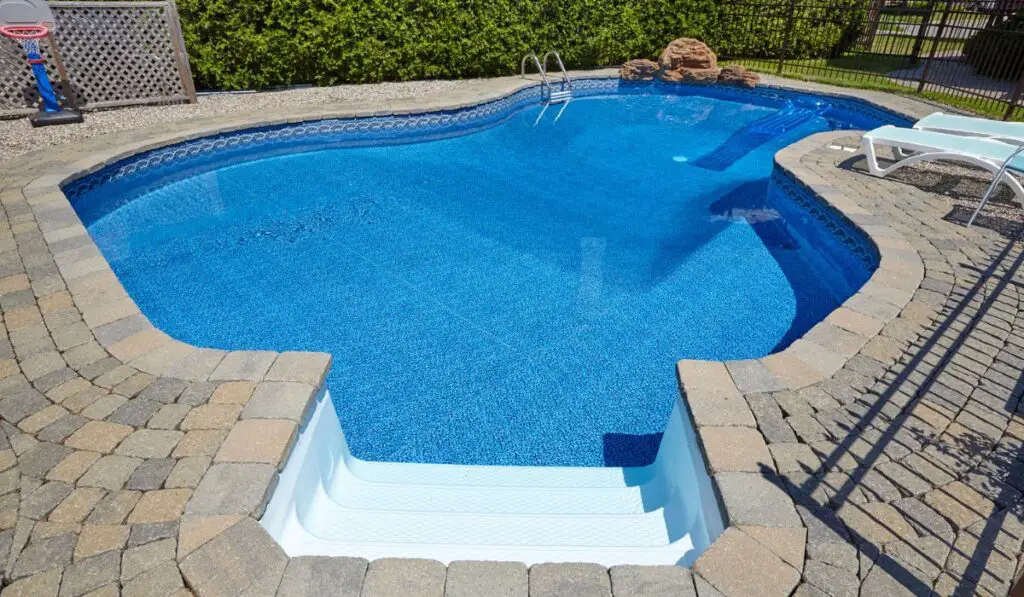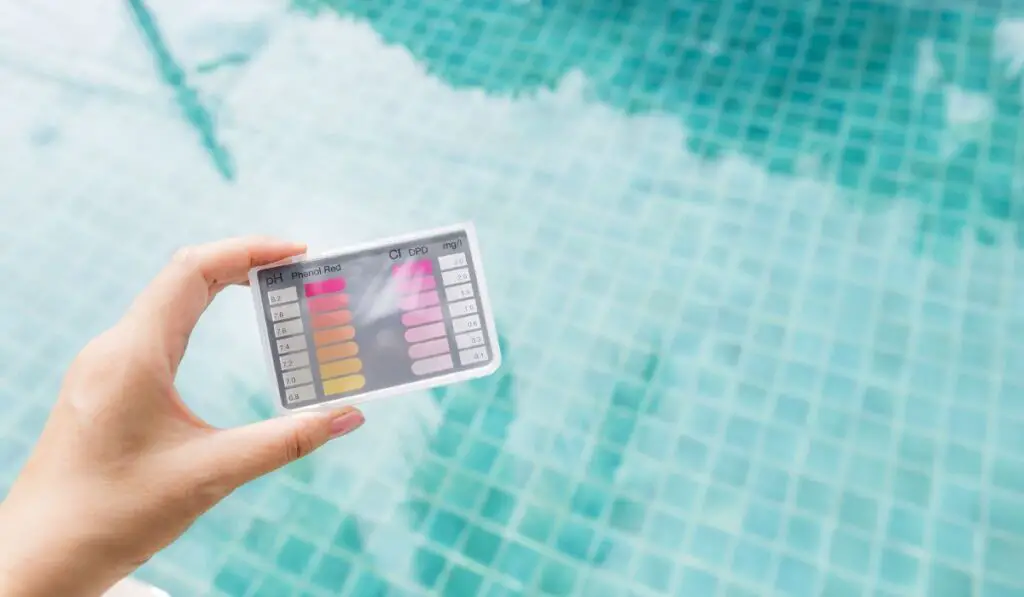Are you noticing your pool water isn’t as sparkling clean as it used to be? Did you just have a pool party, and now there’s a green tint to the water? Or maybe you’ve been using the same amount of chemicals, but they just don’t seem to be working as well as you before? If any of these situations sounds familiar, chances are your pool has high phosphate levels. So, how do you remove phosphates from your pool?
Phosphates can be removed from pool water using a phosphate removers, which are made of Lanthanum chloride or aluminum chloride. These substances bind to the phosphates in the water and then sink to the bottom of the pool where they can be vacuumed up.
Phosphates weren’t as big of an issue a few years ago, but with the popularity of phosphate-based anti-corrosive agents and fertilizers, they’ve become more and more common in pool water. Now you have to deal with an extra pollutant before enjoying your crystal clear pool. Let’s look at different methods to bring those phosphate levels down and get your pool back to looking its best.
Are Phosphates in Pool Water Dangerous?

The simple answer is no; phosphates in your pool water aren’t dangerous. In fact, they’re an important part of the aquatic ecosystem and play a role in plant and animal growth.
But since you don’t want anything growing in your pool water, they’re kind of a pain. Phosphates aren’t dangerous, but they can lead to:
- Algae blooms
- Cloudy water
- Poor chlorine efficacy
High phosphate levels are often the result of runoff from nearby lawns or gardens that have been treated with phosphate-based fertilizers. When it rains, those phosphates are carried into your pool water, and the problems start.
Algae and bacteria love phosphates, so they’ll start to bloom, making your pool water cloudy and green. As the phosphates increase, you’ll start seeing more algae.
Algae not only looks unsightly but can also be dangerous for swimmers, causing skin and eye irritation. Additionally, the algae will consume chlorine, making it less effective at killing bacteria and keeping your pool water clean.
So while phosphates aren’t dangerous, keeping their levels down is important if you want to maintain a clean and clear pool.
Do Phosphates Affect Saltwater Chlorinators?
Yes, phosphates will affect saltwater chlorinators. They cause the same issues in saltwater pools as in traditional chlorine pools. The only difference is that with a saltwater pool, you also deal with the added issue of corrosion.
Saltwater chlorinators use a process called electrolysis to generate chlorine. In short, the saltwater passes over metal plates that are electrically charged, which in turn splits the water molecules and releases chlorine gas. This chlorine gas is then dissolved into the pool water, where it goes to work keeping your pool clean and bacteria-free.
Orthophosphate, a common phosphate type, is used as a corrosion inhibitor. It helps extend the life of your saltwater chlorinator by protecting it from corrosion. However, too much phosphate (more than 500 ppb overall phosphates) can actually have the opposite effect.
It starts to coat the metal plates in the saltwater chlorinator, which reduces their electrical conductivity and, therefore, the chlorine output. So, not only are high phosphate levels bad for your pool water, but they’re also bad for your chlorinator.
Second, phosphates are linked to chlorine demand or, more appropriately, the loss of chlorine in your pool. More phosphates mean more algae, which means more chlorine is used up to keep the algae in check.
Since chlorinators are set up to maintain a specific chlorine level, this will make the chlorinator run overtime or fail in its attempt to maintain the chlorine level. That’s why sometimes you get all the parameters right, but your chlorine level still seems low.
Pros and Cons of Phosphate Remover
Phosphate removers (on Amazon) are products that help to remove phosphates from your pool water. They work by binding to the phosphate molecules and sinking to the pool’s bottom, where they can be vacuumed out.
While phosphate removers are pretty effective in removing phosphates, they aren’t completely foolproof. Let’s discuss some pros and cons of using a phosphate remover.
Pros:
- As we’ve already discussed, phosphate removers effectively remove phosphates from your pool water. If your city’s water supply is high in phosphates, using a phosphate remover can help to keep your pool water clean and clear.
- A moderate amount of phosphate removers prevent scaling and corrosion, two things that can shorten the lifespan of your saltwater chlorinator and other pool equipment.
- By removing phosphates, you’re reducing the algae in your pool, which means less chlorine is used up, and better pH balance.
- They’re also pretty easy to use; you simply add them to your pool and let them do their job. You can keep using your pool while the phosphate remover works.
Cons:
- Most phosphate removers on the market use lanthanum chloride to bind to the phosphate molecules. Lanthanum isn’t exactly an environment-friendly chemical and is classified as moderately toxic, while phosphates themselves aren’t toxic. So you’re essentially exchanging one problem for another.
- Phosphate removers aren’t algaecide at all. It’s a big misunderstanding that phosphate removers will also kill algae immediately. They don’t. They only remove phosphate, a food source for algae, and even with removers, some phosphate will remain in the water, which is why you would still need an algaecide.
- Phosphate removers cancel the effect of sequestering agents. While sequestering agents are phosphate compounds that remove with free metal in water, phosphate removers bind to the phosphate in sequestering agents, rendering them less effective.
What Should You Do if You Use Too Much Phosphate Remover?
If you’ve added too much phosphate remover to your pool, don’t panic. Simply vacuum the product off your pool’s bottom and continue running your filtration system. The product should bind to the phosphate molecules and then be filtered out of your pool.
However, excessive phosphate removers can also alter the pH levels of your pool water, so it’s important to test your pool water and adjust the pH levels accordingly.
Other Ways to Prevent a Phosphate Buildup in Your Pool
While phosphate removers can help reduce the phosphate levels in your pool, they’re not necessary if you take some preventative measures to keep phosphates out of your pool in the first place.
Here are some detailed tips:
- Test the water you’re adding to your pool for phosphates. This is especially crucial if you live in an area with high metal concentrations in the water supply. Cities frequently add phosphate to their water supply to avoid pipe corrosion.
This way, you can treat the water before adding other chemicals to your pool that may be affected, such as chlorine. - The phosphate route to your pool is usually from leaves, twigs, or other vegetation from around your pool falling in. So, keep the area around your pool clean and free of debris and skim your pool regularly with a pool net (on Amazon).
- Use a pool cover (on Amazon). This will help keep leaves, dust, dirt, and insects or frogs out of your pool water. It’ll also reduce evaporation, so you don’t have to add as much water (and potential phosphates) to your pool.
- Clean the pool skimmer baskets often, so any trapped debris doesn’t have a chance to decompose and release phosphates into your pool water.
- Fertilizer runoff is one of the main sources of phosphate in pool water. If you have a garden near your pool, direct the runoff away from your pool area.
- Regularly brush and vacuum your pool to remove any algae that might be growing. Algae is a big source of phosphates in pool water. Also, use an algaecide to help control algae growth.
- Finally, keep your pool balanced. Proper pH, alkalinity, and calcium hardness levels will help prevent algae growth, and the phosphates will remain checked under normal filtration.
How to Balance Pool Chemical Levels

A balanced pool has a pH level of 7.4 to 7.6, alkalinity of 80 to 120 PPM (parts per million), and calcium hardness between 180 and 400 PPM. When you have these levels in check, your pool is less likely to experience problems, including a phosphate build-up.
Here’s a step-by-step guide to balancing your pool’s pH levels.
1. Testing
First, test your pool water with a reliable pool test kit (on Amazon). You can find these at any pool supply store or online. Ensure you get a separate kit to test phosphates because most all-in-one pool test kits don’t include phosphate tests.
If it’s been a while since you first added water to your pool, doing a Total Dissolved Solids (TDS) test (on Amazon) is a good idea. This will tell you the total dissolved organic or inorganic substances in your pool water, which gives a good indication of how much “gunk” is there and if the water needs balancing.
The acceptable TDS level for pool water is under 2000 PPM; any higher, and you’ll want to do a partial drain and refill your pool.
2. Alkalinity and pH balancing
Once you know the current levels, you’ll first want to adjust the alkalinity level.
Add sodium bicarbonate (baking soda) or sodium carbonate (soda ash) to raise the alkalinity. To lower the alkalinity, use either Muriatic acid or dry acid.
These chemicals will also lower the pH of your pool water, so you’ll need to be careful not to lower it too much. Ideally, test the pH again and balance it between 7.4 and 7.6, using the same chemicals.
3. Hardness Adjustment
Raise the hardness by using calcium chloride or calcium sulfate. To lower the hardness, use sodium hexametaphosphate, which is a flocculent. It will collect calcium in the form of particles and make them large enough to be filtered out.
It’s also recommended to dilute pool water with fresh water if the hardness is too high.
4. Sanitizer
Chlorine is the most popular sanitizer choice because it’s effective and relatively inexpensive. You can find chlorine tablets or granules added to a chemical feeder or skimmer basket.
There are also chlorine alternatives, such as bromine, biguanide, and ozone generators. These options are usually more expensive, but some people prefer them because they’re considered less harsh on swimmers’ skin and eyes.
5. Pool Shock
Shocking means adding a high chlorine concentration (usually 3-5 times the normal amount) to kill off any bacteria or algae growing in the water. This refreshes your pool and is generally done once a week or after heavy rain or swimmers.
Wait 24 hours before swimming after shocking your pool, and always test the pH and chlorine levels to ensure they’re back within the acceptable range.
Your pool is now ready for swimming season! Just remember to regularly test the water, clean the filter, and vacuum the pool.
